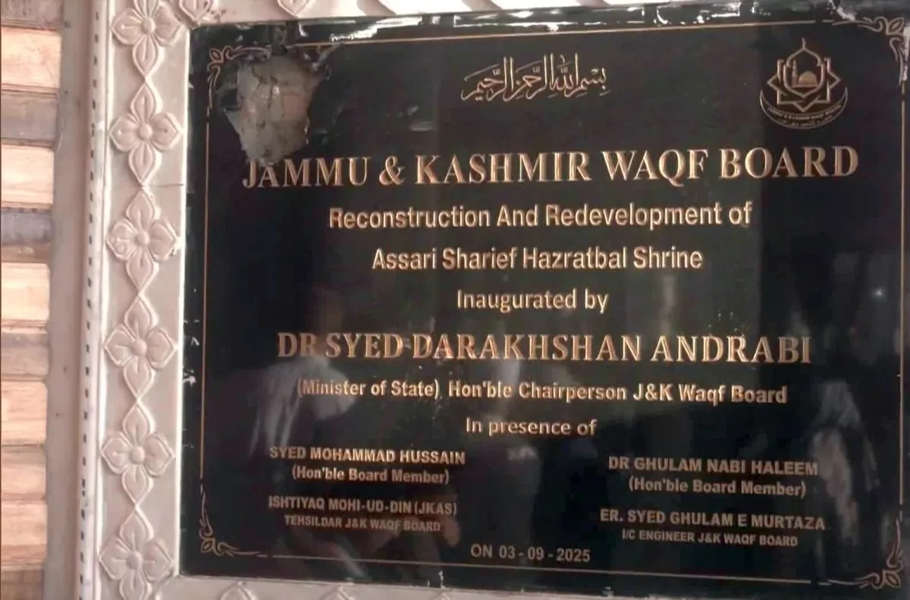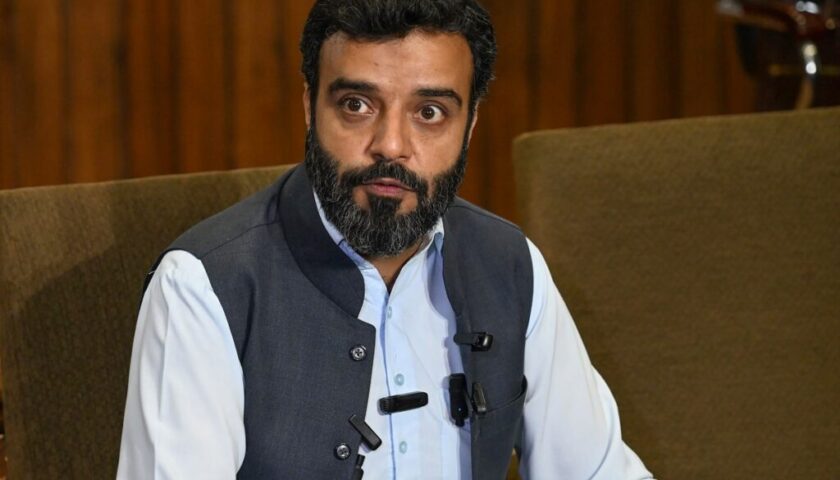Hazratbal Shrine Emblem Controversy Explained – BJP, NC, PDP & Waqf Clash Over National Emblem in Kashmir
By: Javid Amin | 06 September 2025
When Faith Meets Politics in Kashmir
The Hazratbal Shrine in Srinagar is more than a mosque. For Kashmiris, it is a spiritual heartbeat—housing the revered relic believed to be a strand of Prophet Muhammad’s hair. Over centuries, Hazratbal has withstood wars, political changes, and social upheavals, while remaining a sanctuary of faith.
But in September 2025, the shrine became the epicenter of a storm over symbolism. The Jammu & Kashmir Waqf Board, under BJP leader Dr. Darakhshan Andrabi, installed a renovation plaque featuring the Ashoka Pillar, India’s national emblem. What should have been a routine act of renovation turned into a political and religious flashpoint.
During Eid-e-Milad prayers, worshippers protested, vandalized the plaque, and demanded its removal. Within hours, the issue escalated into FIRs, detentions, political slugfests, and demands for Andrabi’s resignation.
The controversy over a marble plaque is not just about stone—it’s about identity, religious autonomy, political symbolism, and governance in Kashmir.
What Sparked the Hazratbal Controversy?
The trigger was the installation of a renovation plaque that bore the Ashoka Pillar, India’s national emblem.
-
The Waqf Board said it was meant as a symbol of national pride.
-
Worshippers saw it as an intrusion of state symbols into a sacred space, where Islamic teachings prohibit idol-like depictions.
-
Opposition parties accused the BJP of politicizing shrines.
Timeline of Events
-
September 5, 2025 – Eid-e-Milad prayers at Hazratbal. Worshippers notice the emblem, shout slogans, and vandalize the plaque.
-
September 6, 2025 – Police register FIR under the Bharatiya Nyaya Sanhita for rioting, conspiracy, and disturbing religious assembly.
-
September 7, 2025 – 26 worshippers detained after CCTV footage review.
-
September 8, 2025 – Political storm erupts: NC, PDP, and MMU demand Andrabi’s resignation. BJP defends her and calls the vandalism a “terrorist act.”
Stakeholders and Their Stances
| Stakeholder | Position | Key Statement |
|---|---|---|
| BJP | Condemned vandalism, defended emblem | Called the protest a “terrorist act,” demanded PSA action against worshippers |
| Waqf Board (Dr. Darakhshan Andrabi) | Defended emblem | “It is a mark of national pride. Opponents are politicizing faith.” |
| National Conference (Omar Abdullah) | Called it a mistake | “Mosques are not government institutions. Emblems don’t belong there.” |
| PDP (Mehbooba Mufti) | Called it blasphemy | Demanded FIR under blasphemy provisions against Andrabi |
| People’s Conference (Sajad Lone) | Urged restraint | “Regrettable decision. Don’t escalate further.” |
| Mutahida Majlis-e-Ulema (MMU) | Demanded consultation | “Waqf must consult religious scholars before such decisions.” |
| Civil Society | Deeply divided | Some see emblem as unity, others as intrusion |
Why Religious Symbolism Matters in Kashmir
Hazratbal is not just a religious site—it’s a marker of Kashmiri Muslim identity. Any change to its sanctity is seen as a change to the community itself.
Islamic Perspective
-
Islam prohibits sculpted or idol-like representations in places of worship.
-
The Ashoka Pillar, though not a deity, is a sculpted emblem, creating discomfort.
-
Religious leaders say this blurs lines between state power and sacred space.
Political Context
-
BJP projects the emblem as national integration.
-
Opposition parties see it as an attempt to “Indianize” shrines and erode Kashmir’s cultural autonomy.
Public Sentiment
For locals, Hazratbal is sacred. Even minor changes—like introducing state symbols—feel like a violation of trust and tradition.
The Deeper Tensions: Faith vs Governance
This controversy is not just about a plaque—it’s about who controls Kashmir’s sacred spaces.
-
The Waqf Board: Under BJP’s influence since 2019, accused of turning shrines into instruments of state control.
-
Political Opposition: NC and PDP argue shrines must remain independent of politics.
-
Common Kashmiris: Fear that shrines may lose their religious character and become extensions of government propaganda.
Political Fallout: Calls for Andrabi’s Removal
-
Omar Abdullah (NC): Called the plaque an “unnecessary mistake,” demanded apology and Andrabi’s dismissal.
-
Tanvir Sadiq (NC): Accused Andrabi of “planting a crisis” for political gain.
-
Mehbooba Mufti (PDP): Called it “blasphemous,” demanded dissolution of Waqf Board.
-
Aga Ruhullah Mehdi (NC MP): Said emblem installation was about “monumentalising egos, not devotion.”
-
BJP & Shiv Sena: Defended Andrabi, called protest “attack on national symbols.”
Legal & Constitutional Dimensions
The issue raises important questions under Indian law:
-
State Emblem of India (Prohibition of Improper Use) Act, 2005 – Prevents misuse of the emblem. Opposition argues its use at Hazratbal is improper.
-
Article 25, Indian Constitution – Guarantees freedom of religion. Protestors argue this freedom was violated by imposing state symbols inside mosques.
-
Bharatiya Nyaya Sanhita FIR – Worshippers face rioting charges, but leaders argue wrong people are being criminalized.
Global Parallels: When State and Sacred Collide
-
Turkey’s Hagia Sophia – Converted multiple times between church and mosque, sparking global debates.
-
France’s Laïcité (Secularism) – State symbols strictly kept away from religion.
-
Ayodhya (India) – Clash over sacred vs political space continues to define politics.
Hazratbal controversy echoes these struggles—where to draw the line between governance and God.
Voices from the Ground: What Kashmiris Say
-
Shazia, student (Srinagar): “We don’t oppose India. We oppose mixing politics with our Prophet’s shrine.”
-
Rashid, shopkeeper near Hazratbal: “Our shrine is sacred. Why put government marks inside?”
-
Farooq, retired teacher: “This is about control. First land, now shrines.”
What Next? Pathways to Resolution
-
Independent Religious Committee – Consult Ulema before any shrine-related decisions.
-
Policy Clarity – Separate governance from faith in Waqf management.
-
Dialogue – Between govt, opposition, and civil society to avoid polarization.
-
Accountability – Audit Waqf Board finances and decision-making.
-
Respect for Sentiments – Ensure shrines retain their sanctity free of political branding.
Bottom-Line: More Than a Plaque
The Hazratbal emblem controversy is not just about a marble plaque—it is about the soul of Kashmir’s identity.
For the BJP, it is about national pride.
For opposition parties, it is about religious autonomy.
For ordinary Kashmiris, it is about respect for faith.
Unless handled sensitively, this controversy risks deepening the trust deficit between state institutions and Kashmiri society. The shrine that should unite people in prayer has instead become a battleground for politics.




